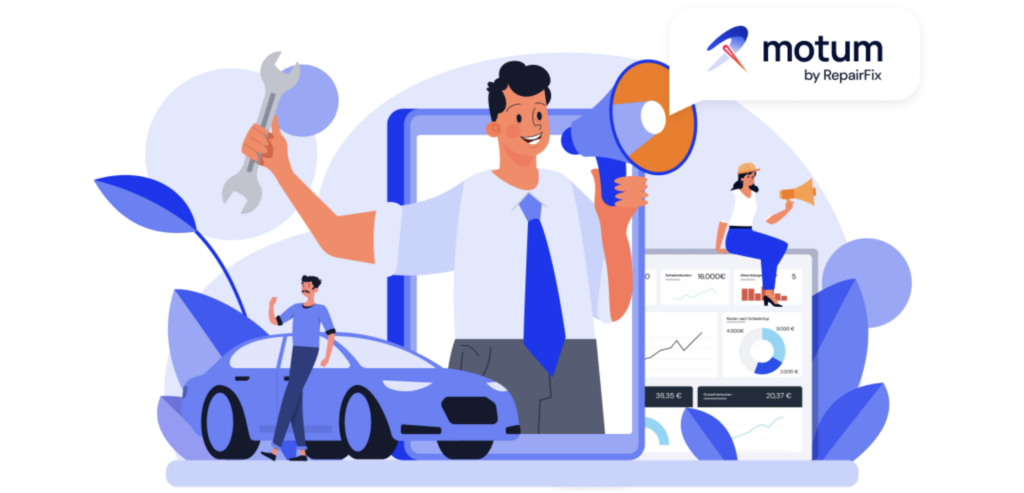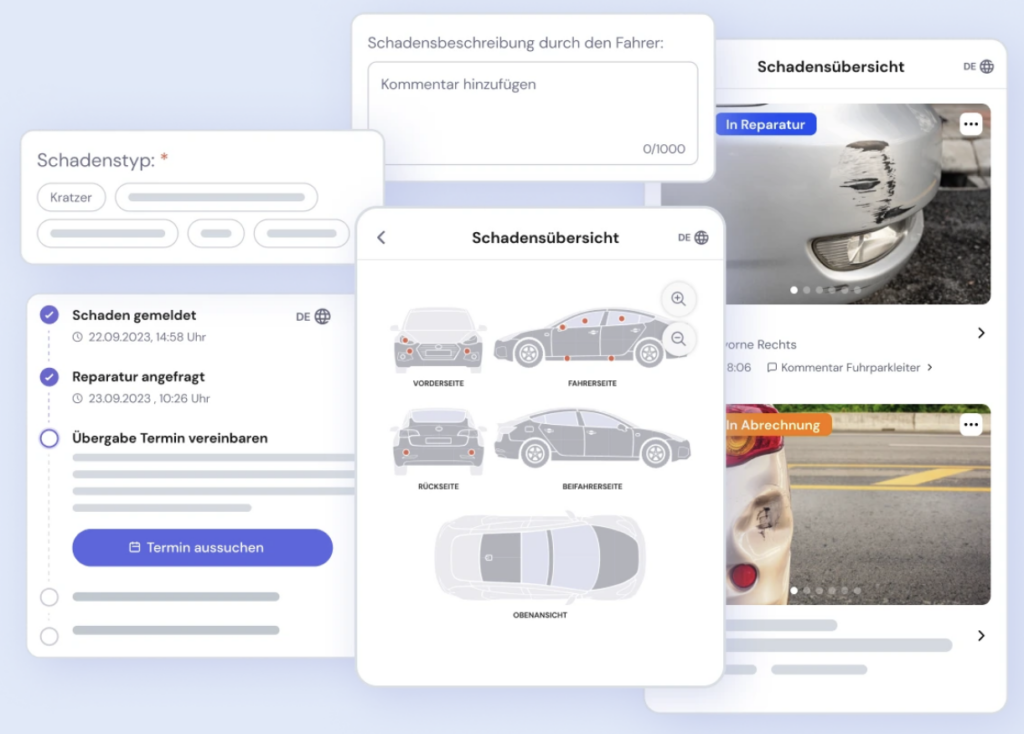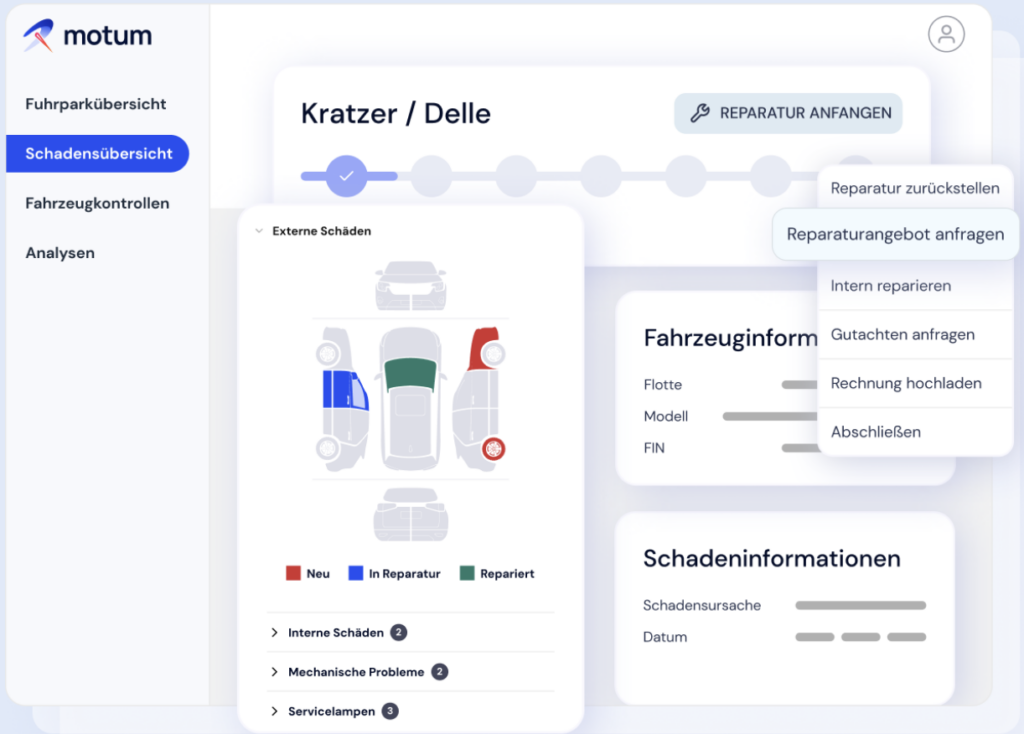
Context:
Just imagine: You park and overlook a lamppost. BANG. You get out and have a small dent and paint damage on your car. Oh no, where do I go now? You are searching on Google for bodyshops nearby. First hit, no phone number available. Second hit, no address information. Third hit, no opening times. This will be a long story.
The Digital Incubation Unit, a corporate division of the BASF Coatings GmbH, has dealt with precisely this problem. The DIU discovers and validates digital business models and corporate ventures for BASF’s Coatings division. DIU put itself in the customer’s shoes, validated the problem, created a solution-oriented prototype, tested it, and then successfully integrated it. The result is:
“motum – a digital platform in the event of damage and service.”
Phases:
The team has gone through various phases. After each of these phases, the go’s and no-go’s were defined to see whether lessons learned would be taken into the next phase or, to put it bluntly, whether further development of the venture had any future at all.
1. Identify and define the Problem:
In the first instance the DIU identified and defined the specific problem with the customers concerned to develop a tailor-made solution for the actual problem in an internal workshop. In addition to desk research, interviews were conducted to understand the problem in more detail and to examine the needs from different perspectives. The solution was first validated for B2C customers. After a short time on the market, it was pivoted for the B2B market (focus on fleets).
There is a need for a platform that enables users to report damages and receive a cost estimation, along with information about a bodyshop. But not only the opportunity of repairs was interesting, also maintenance services for B2B customers could be of interest as it could lead to higher average revenue per user (ARPU). Customers always have to do the process manually by searching for bodyshops, driving to them, and getting a cost estimation. This step is analog and required a lot of time and therefore also costs. To understand the customers behavior the DIU observed test persons and was thus able to observe a typical procedure. Customers usually check the Google entries and start with the first one that appears. They use the following criteria: Is all information available, does the bodyshop looks serious and trustworthy, do they have a social media account? The DIU noticed that a lot of Google entries are incomplete and important information is missing.
The team put the results in the following problem statement: We need a platform that connects customers and bodyshops with each other so that service and repair work incl. cost estimation can be displayed transparently. For B2B customers, it is also worth considering integrating a general fleet management system.
2. Conceptual & Pilot
After having the specific idea, the team was going to name the different stakeholders. At one point there are the customers, end customers (B2C) and fleet owners (B2B). Another stakeholder are the bodyshops (private or chains). But competitors (direct & indirect) also represent stakeholders. Another stakeholder are insurances and appraiser. The last stakeholder is the BASF Coatings (DIU) itself.
The subsequent milestone entailed the recruitment of end customers and bodyshops for the pilot phase, as well as the execution of interviews with fleet owners to ascertain their specific requirements. With the help of a product documentation, a first draft of the future product was built (MVP). Hereby is only a minimum of requirements and features of the final product/service considered to meet the customer’s needs as effectively as possible. In general, the MVP should be able to:
- Let the customer report the damage by photo.
- Platform receives the claim, assigns, and contacts the bodyshop.
- Bodyshop estimates the damage cost and sends repair description.
- Platform creates and sends the repair offer.
- Driver accepts or rejects offer.
Following the construction and deployment of the minimum viable product (MVP), the team established a network consisting of 25 bodyshops and 100 repairs on the business-to-consumer (B2C) front, along with the execution of two pilot tests involving fleet customers.
During this phase, the team repeatedly asked itself whether the idea was the right solution to the actual problem and whether the continuation of the idea still had potential on the market. Potential questions were e.g. “Does the idea solve a problem of your (potential) customers?” or “Do sufficient customers exist and do they consider it valuable?”.
A significant finding emerged from this phase, indicating that the demand and necessity among business-to-business (B2B) customers surpasses that among business-to-consumer (B2C) customers. Not enough money could be earned on the market with B2C customers (viability), as every customer is a new one. In addition, B2C customers were not willing to install an app for a claim that they only have every few years. With fleets, you have more claims per customer and therefore a higher average revenue per user (ARPU). For this reason, the DIU pivoted the business case and focused on the target group of fleet owners from that moment on, specifically of developing a complete service package from a single source.
3. Venture Growth
In 2019, RepairFix GmbH was founded, and the idea was finally spun off. Since then, RepairFix has been a 100% subsidiary of BASF Coatings GmbH. 2023 RepairFix did a rebranding and became motum, which was the name of the RepairFix platform before. In December 2023, more than 350 customers and over 33,000 vehicles are using motum.

In the following, I would like to describe the finished implemented product, which was first started as a problem validation in the Digital Incubation Unit of BASF Coatings and is now indispensable for many customers.
motum is a platform, which enables a digital claims management and/or the opportunity to maintain vehicles across the entire fleet. Fleet managers, drivers, workshops, appraisers, all relevant parties are connected via the motum platform. This facilitates communication and collaboration and ensures lean processes and maximum transparency.
Potential customers include:
- functional fleets (e.g., ambulance),
- mobility fleets (e.g., carsharing),
- motivation fleets (e.g., company cars),
- and small businesses (e.g., care services).
The main function is still the same: Drivers have the option of reporting accidents and damages on the road via web app. The bodyshop receives it and sends a cost estimation to the fleet owner, who can follow it in the Web-Portal. But also, appraiser and insurer are included. The fleet managers can contact them directly via motum. Thanks to real-time transparency and the use of innovative AI for damage detection, fleet managers can speed up the settlement of claims.


All parties involved are seamlessly connected to motum and see the damage report after approval by the fleet operator. This means that not only the damage reports are smart, but also the approval of vehicle damage for repair. In addition to the recording and management of damage claims, the evaluation with dashboards is another function. Reports and evaluations for fleet management can be created – questions such as “How many repair orders have already been completed?” or “What were the average cost estimates of the relevant damage from the fleet?” which makes their daily work more efficient. However, motum not only offers damage management but also digital car maintenance for the fleet management. This means that the fleet status can be kept permanently in view by displaying necessary checks, handovers, and maintenance. motum also creates a checklist for drivers to complete before and/or after the journey, such as entering the mileage and indicating the fuel/battery level.
The company offers an easy way for the customer to test the system, either in a short demo (here) or with a test account. As soon as the customer decides to work with motum, the company follows a structured process to integrate the system into the existing IT landscape and prepares a smooth start. But the team is also available with training materials and as a point of contact. A well-known customer who has opted for motum is bolt.
Lessons Learned:
- Make sure that the solution solves the actual problem on the market (Problem-solution-fit),
- After each completion of individual phases, list the go’s and no-go’s and take the learnings with you into the next phase,
- Always consider the market size and future potential (e.g. is it a niche, is there market growth),
- Customers are different, not every customer group has the same needs and the same level of demand – Focus on customer segment with high ARPU/customer loyalty.
Sources: https://www.motum.eu



